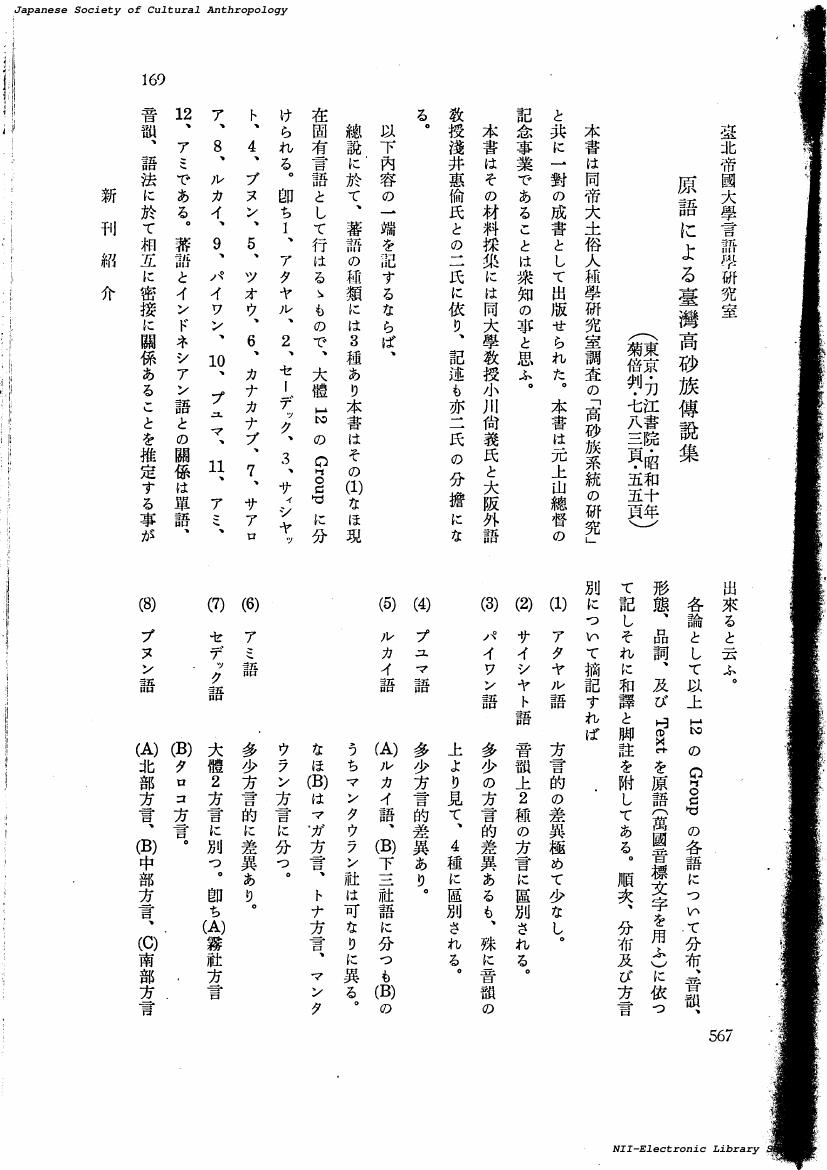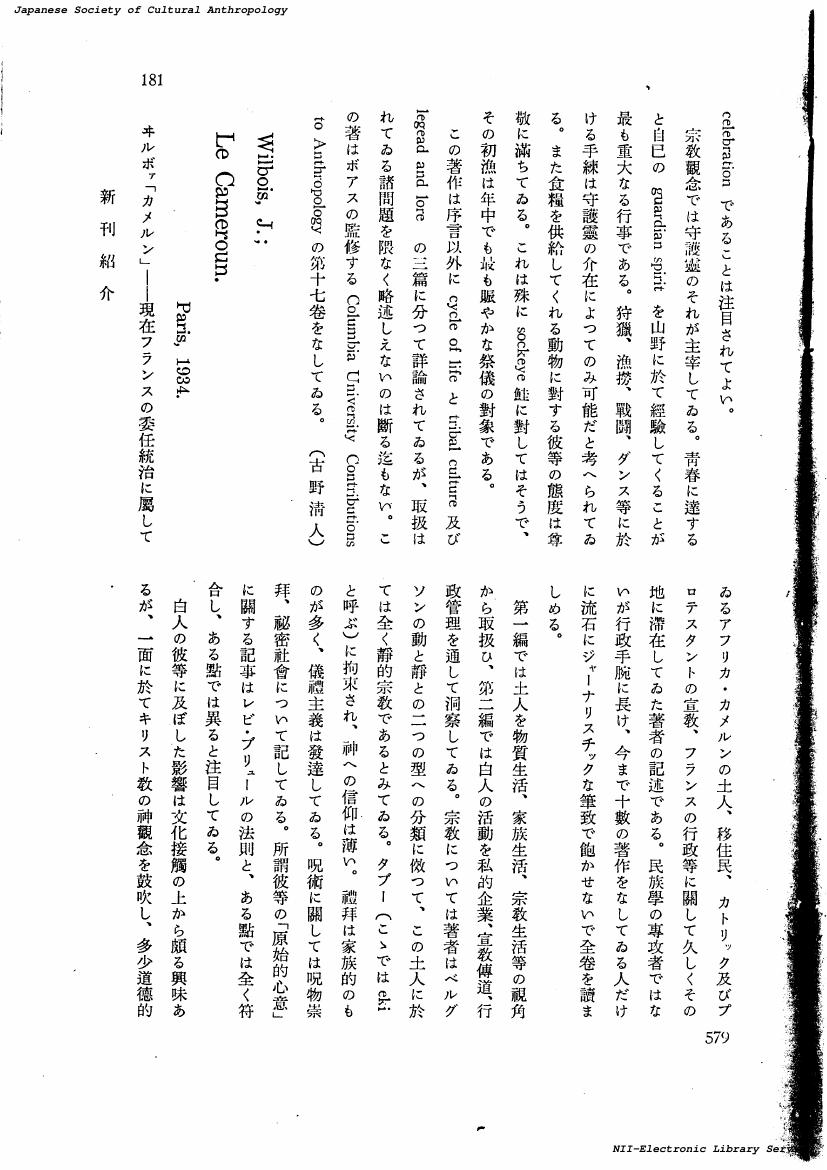1 0 0 0 OA 哀牢夷九隆伝説の探討
- 著者
- 陳 荊和
- 出版者
- 日本文化人類学会
- 雑誌
- 民族學研究 (ISSN:24240508)
- 巻号頁・発行日
- vol.17, no.3-4, pp.203-221, 1953 (Released:2018-03-27)
1 0 0 0 OA 天の御柱と八尋殿についての一考察
- 著者
- ナウマン ネリー
- 出版者
- 日本文化人類学会
- 雑誌
- 民族學研究 (ISSN:24240508)
- 巻号頁・発行日
- vol.36, no.3, pp.193-203, 1971-12-31 (Released:2018-03-27)
- 著者
- 今関 光雄
- 出版者
- 日本文化人類学会
- 雑誌
- 民族學研究 (ISSN:24240508)
- 巻号頁・発行日
- vol.67, no.4, pp.367-387, 2003-03-30 (Released:2018-03-27)
本稿は、「ファン・コミュニティ」の文化人類学的研究というテーマの下に、あるラジオ番組のリスナーたちの行っている「集い」を、フィールドワークによる調査研究に基づいて分析し、オーディエンス/ファン同士のコミュニケーションの重層性を明らかにするものである。リスナーが番組に「告知」を投書し、行う集会を「集い」と呼ぶ。実際に出会うことで友人関係を構築しようという試みである。そこでは、同じ番組に関する情報を持つ「比較可能で代替可能な者」同士の関係を、具体的な「個別性を持った顔のある誰か」同士の関係に変換していくという実践が見られる。これは、メディアを介して作られたファン・コミュニティにおけるコミュニケーションを情報交換のみの関係として語ってきた「おたく」論の一面性を批判するものである。また、オーディエンス研究において「受け手」の能動性を考える場合、受け手の行う「流用」がよく議論される。ここで明らかになるのは、その「流用」がメディア上だけで、すなわち顔の見えない「サイバースペース」だけでなされるのとは違って、「個別性を持った顔のある誰か」との繋がりにおいてなされることが重要であるということである。本稿は、そのような顔の見えない「サイバースペース」における繋がりを「個別性を持った顔のある誰か」との繋がりに変換し、コミュニケーションの重層性を創りだしていることに注目する重要性を明らかにする。それらの実践がメディアによる人びとの分断や抽象空間としての「国民文化」への回収に抵抗する「流用」であるということを示唆する。
1 0 0 0 OA 山と通婚圏
- 著者
- 瀬川 清子
- 出版者
- 日本文化人類学会
- 雑誌
- 民族學研究 (ISSN:24240508)
- 巻号頁・発行日
- vol.32, no.4, pp.270-278, 1968-03-31 (Released:2018-03-27)
The purpose of this article is to investigate changes in the intermarriage spheres of the inhabitants of four villages of hilly districts, throughout the past hundred years or so, with relation to the expansion of the spheres of their village life. In addition to this the writer tries to trace the tradition of old marriage customs in those villages, such as the institution of common houses for young men and women and an old form of marriage in which the husband nightly visits the wife dwelling in her parents home.
1 0 0 0 OA 我国猿まわし芸能集団における芸能の継承と芸能の観客受容
- 著者
- 広瀬 鎮
- 出版者
- 日本文化人類学会
- 雑誌
- 民族學研究 (ISSN:24240508)
- 巻号頁・発行日
- vol.44, no.2, pp.133-159, 1979-09-30 (Released:2018-03-27)
In 1978 in Hikari City Hall, Yamaguchi prefecture, the author delivered a lecture on "Japanese Monkeys and the Japanese People : the History of the Feeling of the Japanese to the Monkey." From this time members of the Sarumawashi no Kai (The Group of Monkey Trainers for the Restoration of Traditional Performances of Monkeys) and the author began a survey of the environment and actual lives of monkey trainers as well as the accompanying lore of the traditional monkey training techniques in Yamaguchi, along the Shimada and Nishiki rivers to their upper basins. Throughout the long history of Japan there has existed a special feeling for the Japanese monkey and the traditional Monkey Performances. Once the monkey was regarded with fear as a sacred animal or as a motif for god, but gradually in the development of Japanese society, the feeling changed. In modern Japan, year by year the traditional monkey lore is vanishing along with the opportunities for Monkey Performances. The author recognizes the fact that in the fields of natural science, ethnology and folklore there is intense interest in the relationship between man and non-human primates. Since ancient times the Japanese attitude toward the Japanese monkey has altered. The Monkey Performances were included events after the feeling of fear of the monkey was conquered. A study of the depth of feeling for the monkey in Japanese culture and the psychological evaluation of monkey lore appeared in Mayazaru Shinko, referring to the belief of the stable with monkey and horse, which had some historical influence in early times. The actual characteristics of Monkey Performances in the religious dances, objects of worship and in documents were arrived at through textual information and successive folklore in Japanese culture. From the medieval period of Japanese history the characteristics and value of the peculiar Monkey Performances gained a reputation in many fields and were respected by the people of Japan. Next, the author dealt with the traditional successive transmission of Monkey Performances, and through a questionnaire of those who appreciated the Monkey Performances in their youth, mentioned the keen observations of those of the Meiji, Taisho and Showa eras. In 1977 the Suwo Sarumawashi no Kai was organized and started the training of monkeys to maintain the Monkey Performances and the members shared the knowledge of training techniques. An analysis was made between the acquired knowledge of the old trainers and their successors, so that the methods of tradittonal training and the understanding of the behavior of monkeys by the old trainers is now known. The consciousness and feeling of the people toward monkeys, and the way the monkey lore has developed in Japan are analyzed, and some comparable feelings toward monkeys could be seen between the trainers and appreciators of monkeys. There is considerable regional variation in the attitude toward monkeys and in different age groups. Since training of the monkeys to stand up had already been started by contemporary trainers of Monkey Performances, it was possible to discuss the methods and to observe the reaction of the people present as the group performed all over the country. The special techniques and the concepts are the result of long experience.
1 0 0 0 OA 相模愛甲郡の道祖神と小正月の行事
- 著者
- 大林 太良
- 出版者
- 日本文化人類学会
- 雑誌
- 民族學研究 (ISSN:24240508)
- 巻号頁・発行日
- vol.23, no.4, pp.324-325, 1959-11-25 (Released:2018-03-27)
1 0 0 0 OA 北海道アイヌの葬制 : 沙流アイヌを中心として
- 著者
- 久保寺 逸彦
- 出版者
- 日本文化人類学会
- 雑誌
- 民族學研究 (ISSN:24240508)
- 巻号頁・発行日
- vol.20, no.3-4, pp.156-203, 1956-12-25 (Released:2018-03-27)
1 0 0 0 OA 日本語と南方語との關係
- 著者
- 松本 信廣
- 出版者
- 日本文化人類学会
- 雑誌
- 民族學研究 (ISSN:24240508)
- 巻号頁・発行日
- vol.13, no.2, pp.99-108, 1948 (Released:2018-03-27)
Of the southern languages which have to some extent been incorporated within Japanese, Mon-Khmer ranks first and Malayo-Polynesian ranks second in the number of words which have influenced the Japanese language. This influence involves many important nouns for all parts of the human body, human relations, heavenly bodies, climate, as well as verbs, adjectives, etc. Moreover, a close morphological relationship can be seen. The prefix plays an important part in the Mon-Khmer and Malayo-Polynesian language groups. Characteristically, causative verbs are formed by the addition of the pa type of prefix. The same usage of p can be found in old Japanese, where the addition of p forms words or causative and emphatic character. Other prefixes, such as ma, which has an honorific meaning in Mon-Khmer, ka, ta, sa, and ya, are common to both languages. This use of the prefixes, which is never found in the old Ural-Altaic languages, has been inherited by Japanese from the southern languages. This is important to bear in mind in studying the origins of the Japanese language.
1 0 0 0 OA 沖縄の「別れ遊び」儀礼の考察 : 若者仲間による葬宴と死者観念
- 著者
- 加藤 正春
- 出版者
- 日本文化人類学会
- 雑誌
- 民族學研究 (ISSN:24240508)
- 巻号頁・発行日
- vol.65, no.3, pp.209-229, 2000-12-30 (Released:2018-03-27)
かつての沖縄では,若者の死の直後に若者仲間が墓に赴き,歌舞音曲をともなった伽をする習俗がみられた。ワカリアシビー(別れ遊び)などと呼ばれたこの儀礼は,死んだ若者のモーアシビー(野遊び。青年男女の野外交遊のこと)仲間が夜毎に墓前に集い,そこで一時を遊び過ごすものであった。儀礼はほぼ一週間ほど続けられたが,いくつかの報告では,幕内から死者の棺箱を出したり,その蓋を開け,死者を座らせて行われることもあったとされている。また,墓前の仮小屋に短く織った手拭い(いんきや織りの手さじ)を飾って集う例も報告されている。儀礼は昭和時代に入ると行われなくなった。本稿では,19例の報告事例の検討から,この儀礼が野遊びの形態をとって死後に行われる若者仲間の追悼儀礼であり,幕内の死者の霊魂を幕前に招き出して行う,生者と死者との直接交流・交歓であることを明らかにする。若者たちが墓前に集まり,棺箱を墓から引き出すのは,死者に近づいて交流しようとする意図であり,短い手拭いをさげるのはそれを霊魂の依代として用い,そこに寄り憑いた死霊を実感するためである。また,引き出した棺箱を開け,死者を座らせるのは,生前と変わらぬ形で死者と直接に交流しようとする試みである。ただし,このような儀礼行為の前提には死の認識があり,死体の変化に対する人々の知識と経験が存在する。なお,儀礼には死霊の危険性に対する忌避観念が表出されていないようにみえる。これは,若者たちが死んだ仲間を追悼するために,死霊の危険性を受け入れた上で儀礼を行っているからである。それは,若者仲間の同輩結合の強さを示すものである。
- 著者
- 磯貝 勇
- 出版者
- 日本文化人類学会
- 雑誌
- 民族學研究 (ISSN:24240508)
- 巻号頁・発行日
- vol.1, no.3, pp.565-566, 1935-07-01 (Released:2018-03-27)
- 著者
- 宮内 悦藏
- 出版者
- 日本文化人類学会
- 雑誌
- 民族學研究 (ISSN:24240508)
- 巻号頁・発行日
- vol.1, no.3, pp.567-568, 1935-07-01 (Released:2018-03-27)
1 0 0 0 OA 山口麻太郎著, 壹岐島昔話集, 東京, 郷士研究社, 四六判, 價一圓八十錢
- 著者
- 關 敬吾
- 出版者
- 日本文化人類学会
- 雑誌
- 民族學研究 (ISSN:24240508)
- 巻号頁・発行日
- vol.1, no.3, pp.568-569, 1935-07-01 (Released:2018-03-27)
- 著者
- 小島 武男
- 出版者
- 日本文化人類学会
- 雑誌
- 民族學研究 (ISSN:24240508)
- 巻号頁・発行日
- vol.1, no.3, pp.569-570, 1935-07-01 (Released:2018-03-27)
1 0 0 0 OA 董家遵氏, 從漢到宋寡婦再嫁俗習考, 中山大學文史學研究所, 月刊第三卷第一期所載
- 著者
- 牧野 巽
- 出版者
- 日本文化人類学会
- 雑誌
- 民族學研究 (ISSN:24240508)
- 巻号頁・発行日
- vol.1, no.3, pp.570-572, 1935-07-01 (Released:2018-03-27)
- 著者
- 村上 俊順
- 出版者
- 日本文化人類学会
- 雑誌
- 民族學研究 (ISSN:24240508)
- 巻号頁・発行日
- vol.1, no.3, pp.572-573, 1935-07-01 (Released:2018-03-27)
- 著者
- 古野 清人
- 出版者
- 日本文化人類学会
- 雑誌
- 民族學研究 (ISSN:24240508)
- 巻号頁・発行日
- vol.1, no.3, pp.573-575, 1935-07-01 (Released:2018-03-27)
- 著者
- 杉浦 健一
- 出版者
- 日本文化人類学会
- 雑誌
- 民族學研究 (ISSN:24240508)
- 巻号頁・発行日
- vol.1, no.3, pp.575-577, 1935-07-01 (Released:2018-03-27)
- 著者
- 古野 清人
- 出版者
- 日本文化人類学会
- 雑誌
- 民族學研究 (ISSN:24240508)
- 巻号頁・発行日
- vol.1, no.3, pp.577-579, 1935-07-01 (Released:2018-03-27)
1 0 0 0 OA Wilbois, J.; Le Cameroun, Paris, 1934
- 著者
- 村上 俊順
- 出版者
- 日本文化人類学会
- 雑誌
- 民族學研究 (ISSN:24240508)
- 巻号頁・発行日
- vol.1, no.3, pp.579-580, 1935-07-01 (Released:2018-03-27)














